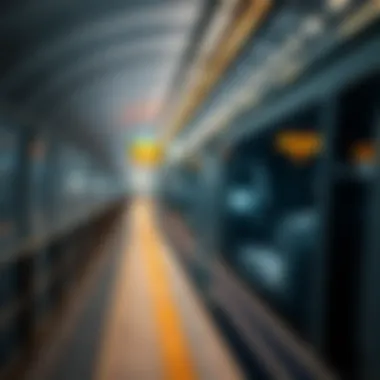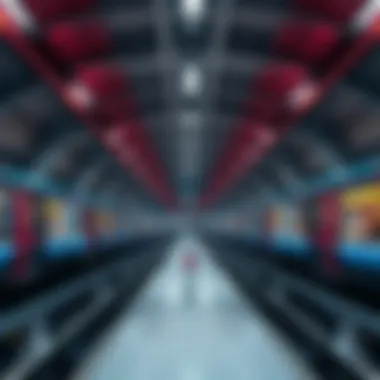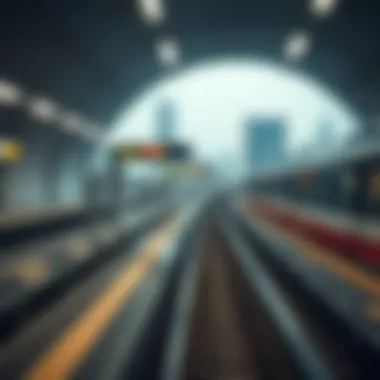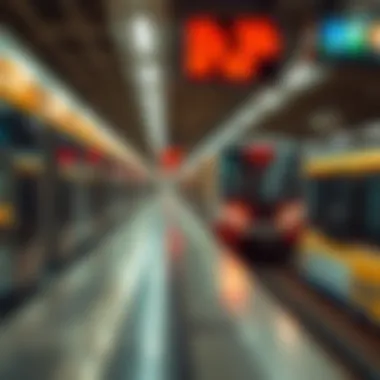Understanding Dubai Metro Timing and Schedule


Intro
The Dubai Metro stands as a testament to the rapid urban development and advancement in transport infrastructure that characterizes the city. Its operational timing plays a pivotal role in the day-to-day lives of both residents and visitors. Understanding the schedule and timing nuances of this extensive transit system is crucial for effective navigation.
Accurate and timely transport services can mean the difference between a seamless commute and hours wasted in traffic. The metro, which connects various parts of the city, intertwines with a network of public transport options, significantly contributing to Dubai's urban dynamics.
In this article, we'll explore how the operational hours of the Dubai Metro are structured, the impact they hold for commuters, and the significance they bear in a city that never seems to slow down. We'll also take a look at peak hour considerations, integration with other transportation modes, and how all these elements play into the broader narrative of urban mobility in a city known for its growth.
Prelims to Dubai Metro
The Dubai Metro stands as a beacon of modern urban transportation within one of the fastest-growing cities in the world. As a cornerstone of Dubai’s public transit, it not only shapes the travel routine of residents but also profoundly influences the overall fabric of urban mobility. Understanding the operational insights into the Metro, particularly its timing, is crucial for anyone navigating daily commutes or planning large-scale events in the city.
In this article, we’ll explore the history of the Metro, its development over the years, and the role it plays in easing urban congestion while promoting sustainable commuting options. The importance of an efficient timing schedule cannot be overstated, especially in a bustling metropolis where every minute counts. Having a clear grasp on when the Metro operates helps commuters plan better, minimizing wait times and enhancing the overall urban experience.
History and Development
When we trace back the origin of the Dubai Metro, we find that it was conceived a little over two decades ago as part of a broader vision to modernize the city's infrastructure. Initiated in 2005, the project saw its first line, the Red Line, officially open in 2009. This ambitious endeavor marked a significant shift in how public transport would be perceived and utilized in the emirate.
The motivation behind this expansive project was multifaceted: reduce traffic congestion, enhance public transport options, and support Dubai's rapid population growth. Over the years, the Metro has expanded to include the Green Line and various extensions that service critical commercial and residential areas. As a result, the Metro is now a key player in Dubai's transportation network, moving millions annually.
Beyond just a means of travel, the Metro's development is tied to urban planning strategies aimed at fostering a vibrant, sustainable city that attracts global talent and tourists alike. The continuing evolution indicates that Dubai is not resting on its laurels; rather, it is committed to refining its public transit systems even further.
The Role of Metro in Urban Mobility
Functioning as a lifeline for daily commuters, the Dubai Metro enhances accessibility across the city, providing a swift and eco-friendly alternative to road travel. The convenience of subway systems cannot be overstated, especially for a city renowned for its rapid development. With stations strategically located near key commercial hubs, residential areas, and recreational facilities, the Metro offers undeniable benefits to all users.
In addition to promoting a cleaner environment by reducing carbon footprints, the effectiveness of the Metro in urban mobility also acts as a catalyst for economic growth. Businesses benefit from increased foot traffic and improved accessibility for employees. Furthermore, the Metro integrates seamlessly with other forms of transport, such as buses and taxis, thus creating a cohesive transit network that compliments the vibrant lifestyle of Dubai.
Commuters who utilize this system save time and other resources, allowing them to focus on activities that matter most, whether that's work, leisure, or community engagement. Ultimately, the Dubai Metro is not just a transportation system; it represents the future of mobility in urban settings. The insights we cover in this article aim to illuminate this dynamic and highlight the way forward.
Dubai Metro Operational Hours
Understanding the operational hours of the Dubai Metro is vital for both daily commuters and those who occasionally use the system. The Metro plays a crucial role in facilitating seamless travel across the city, so grasping its operational timing ensures that users can plan their journeys efficiently.
Moreover, the timing reflects the Metro's response to the diverse needs of its users. With a blend of residents, tourists, and business travelers, the service aims to accommodate varying schedules. Comprehending how the hours align with peak activity levels can provide insight into user behavior and preferences, offering valuable information to investors and analysts alike.
Weekday Schedule
Weekdays set the tone for public transit utilization. The Dubai Metro operates with a robust schedule during these days, starting early in the morning and extending late into the evening. Typically, the Metro service begins around 5:30 AM and wraps up by midnight. During this timeframe, trains run frequently—approximately every 7 to 10 minutes—depending on the time of day. The morning rush (around 7-9 AM) attracts commuters heading to work, while the evening (around 5-8 PM) sees a similar uptick as people return home.
This predictable schedule not only supports commuters but also enhances the overall efficiency of urban mobility. By aligning the service with typical working hours, the Metro reduces the chances of overcrowding and makes commuting smoother.
Weekend Schedule
On weekends, the operational hours shift slightly, demonstrating adaptability to the lifestyle of the Dubai populace. Generally, the Metro runs from around 10 AM until 1 AM the following day, giving night owls a chance to enjoy Dubai’s vibrant nightlife without needing to worry about getting home. Trains during weekends may operate on a slightly less frequent basis—approximately every 10 to 12 minutes—but they are timely enough to cater to those out for leisure, shopping, or socializing.
This change in schedule also illustrates how the Metro accommodates the flow of activities in Dubai. It is designed for both leisure travel and cultural events, highlighting the Metro's role in connecting residents with the diverse offerings of the city.
Public Holiday Adjustments


Public holidays present a unique challenge for transportation systems. The Dubai Metro is no exception; its operational schedule adapts to these occasions. On notable public holidays, such as Eid or National Day, the service may extend its hours, allowing more people to travel as they partake in celebrations or family gatherings.
For instance, you might find the Metro running later than usual, perhaps until 2 AM during such festivities. It’s important for riders to check the Dubai Metro's official website or mobile app for specific adjustments before planning their journeys.
Such flexibility not only enhances accessibility but also showcases the commitment of the Dubai Metro to serve its community, fostering a sense of unity during celebratory times.
In summary, the operational hours of the Dubai Metro are tailored to meet the daily and occasional demands of its users. From the weekday rush to weekend excursions and holiday celebrations, these timings play a pivotal role in shaping the urban landscape and enhancing commuter experience in this dynamic metropolis. For more information, travelers can visit the official RTA website to stay updated on schedules and changes.
Significance of Timely Services
In the bustling environment of Dubai, the timely operation of the Metro system is not just a luxury; it’s a necessity. Effective public transportation plays a pivotal role in any urban setting, and the Dubai Metro stands as a key component in facilitating the city’s vibrant life. The importance of timely services extends beyond mere convenience; it encompasses economic, social, and environmental dimensions that affect nearly every facet of urban living.
Commuter Efficiency
One of the standout features of the Dubai Metro is its commitment to commuter efficiency. With an extensive network that includes multiple lines and numerous stops, this transit system is designed to minimize delays and maximize accessibility. The operational timings are carefully calibrated to meet the needs of the commuting populace—whether they’re heading to work, school, or leisure activities.
Benefits of Timely Operations:
- Streamlined Commutes: The Metro runs every few minutes during peak hours, allowing commuters to hop on without waiting for long periods. This immediacy can make a significant difference for busy professionals or students.
- Reliable Connections: By adhering to set schedules, these trains ensure that connections to buses and trams are seamless. A commuter can rely on the metro's timetable, knowing they won’t miss a transfer to another transport mode.
- Reduced Stress Levels: Knowing when the next train arrives can alleviate the anxiety often associated with long commutes. This reliable timetable cultivates a more serene commuting experience.
In light of these advantages, the Metro significantly enhances the overall efficiency of daily travel in Dubai. Commuters can plan their journeys with confidence, leading to increased productivity and a better quality of life.
Impact on Traffic Congestion
Timely services also have a crucial role in alleviating traffic congestion in a rapidly growing metropolis like Dubai. The city is known for its bustling streets that can become congested during peak hours. A functional public transit system reduces the number of single-occupancy vehicles on the road, directly impacting overall traffic flow.
How Expeditious Metro Services Help:
- Encouraging Public Transport Use: When the Metro operates on a stringent timetable, more residents are likely to opt for this mode of transport rather than driving their own vehicles. For instance, if an average commuter finds the Metro easier and faster, it encourages more people to make this their primary mode of travel.
- Decreasing Road Traffic: Fewer cars on the road translate to lower traffic congestion, which benefits all road users. This reduction not only enhances the commuting experience but also significantly cuts down on travel time.
- Environmental Benefits: With fewer vehicles emitting pollutants, the city can achieve better air quality and work towards its sustainability goals. Less reliance on personal vehicles lowers carbon emissions and contributes to a cleaner environment.
The significance of timely services in the context of the Dubai Metro cannot be overstated. It serves not only to improve individual commuter experiences but also serves broader urban mobility goals, making the city more navigable for everyone.
"A functioning public transport system is the backbone of any well-organized city, and the Dubai Metro exemplifies this principle through its timely services."
Ultimately, the implications of time management in public transport extend far and wide. It shapes the economic prospects of the city, fosters a sense of community, and promotes environmental sustainability. By committing to these timely operations, Dubai continues to enhance its reputation as a global city thriving on innovation and accessibility.
Infrastructure and Design
The infrastructure and design of the Dubai Metro system play a pivotal role in shaping the commuting experience for residents and visitors. A well-thought-out design impacts not only the efficiency of the metro service itself but also the overall integration within the urban fabric of Dubai. The significance of this section lies in understanding how the metro system's physical and operational layout supports its mission of providing timely and effective public transport.
Station Design and Facilities
Each metro station in Dubai is engineered as more than just a stop along the line; it serves as a vital nexus of convenience, safety, and accessibility for commuters. The architectural style blends modernity with local cultural elements, creating spaces that are visually appealing while remaining highly functional.
Key aspects of station design include:
- Accessibility Features: Elevators, ramps, and tactile guidance systems foster inclusivity for all travelers, including those with disabilities.
- Safety Measures: The stations are equipped with surveillance cameras, emergency communication systems, and well-trained staff to ensure commuters feel secure at all times.
- Amenities: Facilities such as clean restrooms, waiting areas, and vending machines contribute to a more comfortable journey.
- Aesthetic Value: The design incorporates large glass panels that offer natural lighting and scenic views, allowing passengers to appreciate the cityscape while they wait.
The combination of these elements serves a dual purpose: enhancing user experience while promoting the metro as a viable alternative to car travel. This conscious focus on the environment and people exemplifies the ethos behind Dubai's commitment to sustainable urban development.
Integration with Other Transport Modes


Seamless integration of the Dubai Metro with other forms of transportation is crucial in fostering an efficient urban mobility system. This multi-modal connectivity offers myriad benefits:
- Intermodal Transfers: Metro stations are strategically located near bus stops, taxis, and ride-sharing zones to facilitate easy transitions between different transport modes. For instance, the connection between the metro and the Dubai Tram is distinctly designed to ensure that passengers can switch effortlessly between lines.
- Smart Ticketing Systems: The unified Nol card system allows users to use the same card for metro rides and other public transport, reducing the hassle of multiple tickets and enhancing user satisfaction.
- Promoting Public Transport: By wisely investing in bus services that sync with metro schedules, the authorities have effectively reduced reliance on private vehicles, contributing to lower traffic congestion and pollution.
- Urban Planning Synergy: The integration strategy aligns with the UAE's Vision 2021, which aims to create a world-class infrastructure and improve public transport options.
"The metro is more than a transportation system; it’s a lifeline, a bridge between communities and opportunities."
For further reading on urban transport systems, you can visit Wikipedia on Metro Systems and Britannica's overview of Urban Mobility.
Learn about local transit policies from Dubai's Roads and Transport Authority.
Peak Hours and Demand
Understanding peak hours and demand is integral to the operational efficiency of the Dubai Metro system. This section examines how these factors influence both the users of the metro and the overall transportation strategy in the city. Recognizing when demand surges allows for better resource allocation, ultimately enhancing commuter experience and minimizing delays.
Identifying Peak Times
Identifying peak times is essential for both the Metro authority and passengers. During weekdays, peak hours typically occur in the morning between 7 AM to 9 AM and in the evening from around 5 PM to 7 PM. These periods align with standard work schedules, making them predictably busy. Conversely, Saturday and Sunday present a different pattern, where peak times can vary significantly based on shopping and entertainment activities, particularly in areas like Dubai Mall or Global Village.
Factors contributing to peak hours include:
- Workforce Commuting: The influx of office workers during morning hours.
- Tourism: Increased metropolitan traffic during weekends and holidays.
- Events and Festivals: Special occasions that could draw crowds to specific areas, impacting transport routes.
Recording and analyzing operational data enables the metro planners to tailor services. For example, travel data can reveal alternate routes or suggest off-peak travel options to commuters. The differences in passenger behavior reflect not only the socio-economic rhythm of the city but also how effectively the Dubai Metro adapts to changing patterns.
Strategies for Managing Crowds
Managing crowds effectively during peak hours is a juggling act that necessitates both planning and real-time responsiveness. The Dubai Metro has implemented several strategies to manage the influx of passengers during these high-demand periods. Considerably, the following approaches have come to the forefront:
- Increased Train Frequencies: During known peak times, the scheduling of trains increases, thereby reducing wait times. This can prevent bottlenecks during rush hours.
- Dedicated Train Cars: Designating specific train cars for women and children provides comfort and safety, alleviating some potential crowding fears.
- Real-time Updates: Digital displays at stations inform passengers about train arrivals in real-time, allowing them to make informed decisions about boarding the next available train.
- Staff Deployment: Enhanced staff presence during peak periods helps to direct and manage passengers effectively, minimizing confusion and maintaining order at stations.
- Smart Ticketing Systems: The introduction of mobile payments and contactless ticketing has revolutionized the boarding process, allowing faster entry into the metro, and thus easing congestion.
"Efficient management during peak hours not only enhances rider satisfaction but also optimizes operational capabilities for the Dubai Metro."
User Experience and Accessibility
The user experience within the Dubai Metro is paramount for ensuring efficient travel across the bustling city. Accessibility isn’t just a buzzword; it’s key in creating a transport system that caters to every individual, regardless of their physical ability or prior knowledge of the system. Improvements and initiatives aimed at enhancing user experience directly translate into greater satisfaction among residents and visitors alike. By prioritizing the ease of use and accessibility of the metro, Dubai positions itself as a forward-thinking metropolis that values inclusivity.
Ticketing System Overview
The ticketing system used by Dubai Metro is designed to be straightforward. With a blend of physical and digital options, it accommodates various passenger preferences. The Nol card system allows users to travel seamlessly throughout the metro while also integrating with buses and trams.
- Types of Nol Cards:
- Red Nol Card: Best for tourists, it can be loaded with up to 10 single journeys.
- Silver Nol Card: This one is reusable and ideal for regular commuters, with a possibility of topping it up as needed.
- Gold Nol Card: For those who fancy a bit of luxury, it allows access to Gold Class seating on the metro.
The introduction of a mobile app has also made the process more efficient. Users can purchase tickets, check schedules, or add funds to their cards. Plus, this digital integration means travelers don’t need to fumble with cash while navigating the urban sprawl.
"A well-structured ticketing system not only facilitates a smoother passenger experience but also encourages more users to adopt public transportation, which ultimately helps reduce traffic congestion."
Accessibility for Disabled Passengers


Attention to the accessibility needs of disabled passengers is crucial for any public transport system. The Dubai Metro is particularly attentive to this issue, ensuring that individuals with disabilities can navigate the metro system comfortably.
Key features include:
- Elevators and Ramps: All metro stations are equipped with elevators and ramps to accommodate those using wheelchairs or mobility aids.
- Braille Signage: Essential for visually impaired passengers, signage in Braille assists in navigating stations and determining where exits are located.
- Designated Spaces: Trains have dedicated areas for wheelchairs, ensuring that these passengers can travel without obstruction.
Moreover, staff are trained to assist passengers who need help, creating a welcoming environment. This level of service, focusing on accessibility, resonates well with the broader community, establishing a culture that fosters respect and consideration for all.
To further explore the accessibility features, Dubai’s Road and Transport Authority (RTA) website here provides detailed guidelines and resources for those who may need it.
Future Developments
Future developments in the Dubai Metro system hold significant importance not only for the transportation network but also for the economic, cultural, and social landscape of the city. As Dubai continues to grow at a rapid pace, the enhancements to the metro system are necessary to keep up with the increasing demand for efficient and reliable transportation. The proposed projects aim to elevate the overall user experience and ensure that the metro remains a viable option for all residents and visitors.
Proposed Extensions
One of the most talked-about aspects of future developments is the proposed extensions of the current metro lines. These extensions are designed to reach areas that are currently underserved by the metro system, which will undoubtedly cater to a growing population that needs access to employment centers, educational institutions, and recreational venues.
For instance:
- The Red Line is set to extend further into the Dubai Investments Park area. This area is expected to see a surge in residential complexes, and the extension will provide essential connectivity.
- Similarly, an extension of the Green Line towards the Dubai Creek will facilitate easier access to the historical sectors, appealing to both tourists and locals alike.
- Another proposal focuses on creating a new line that connects the suburbs with key business districts, significantly cutting down travel time and easing congestion on the roads.
These extensions are not merely infrastructural adjustments; they symbolize a commitment to sustainability and urban planning that aligns with the visionary goals of Dubai. Each extension comes with its set of challenges and considerations, such as ensuring minimal disruption during construction and accurately gauging future ridership demand.
Technological Enhancements
In addition to physical expansions, planned technological enhancements signify a new era for the Dubai Metro. The integration of advanced technology is paramount to maintaining the efficiency of the metro while significantly improving the user experience. Some key aspects include:
- Smart Ticketing Systems: The introduction of contactless payment and mobile ticketing options are on the horizon. This leap towards digitization will make transactions quicker and more user-friendly, especially beneficial for tourists unfamiliar with the local currency.
- Real-time Data and Communication: Upgrades to communication systems mean that commuters can expect better real-time updates regarding train schedules, delays, or changes in service. Innovative apps will likely allow passengers to plan their journeys with precision.
- Sustainability Initiatives: Upcoming developments will incorporate energy-efficient systems, such as solar panels at stations to reduce the environmental footprint.
- AI and Predictive Analytics: Using artificial intelligence for predictive maintenance will help in preemptively identifying issues with train cars and tracks, ultimately contributing to a smoother operational flow.
Technological advancements back the ambition of making the metro not just a mode of transport, but a cornerstone of Dubai's public infrastructure. Such investments offer a promising outlook for residents and visitors, creating seamless travel experiences in this bustling metropolis.
With these proposed extensions and technological enhancements, the Dubai Metro is poised for robust growth and innovation, ensuring its place as a fundamental aspect of contemporary urban living.
Culmination
The significance of understanding the operational insights into the Dubai Metro's timing cannot be overstated. As urban centers continue to expand rapidly, efficient transportation systems play a pivotal role in maintaining the flow of daily life. In the case of Dubai, the Metro serves as not just a means of transport but also as a crucial element in the city's identity and infrastructure.
Summary of Key Insights
During this exploration, several pivotal elements have surfaced that are essential for both residents and visitors:
- Operational Hours: The Metro runs on a fixed schedule, with variations highlighted during weekdays, weekends, and holidays. This predictability assists commuters in planning their journeys effectively.
- Impact on Urban Mobility: The Metro reduces congestion on the roads, providing a cleaner and faster alternative to traditional vehicles. This is an essential aspect of urban planning in a city like Dubai, known for its bustling lifestyle.
- User Experience: From ticketing to accessibility features, the Metro is designed with a diverse user base in mind, ensuring that it caters to those with disabilities as well.
Collectively, these insights underscore the importance of an effective public transportation system which not only streamlines movement but also fosters a sustainable urban environment.
The Future of Mobility in Dubai
Looking ahead, experts agree that the future of mobility in Dubai hinges on continued innovation and adaptation. With proposed extensions of the Metro system on the horizon, there's substantial opportunity for increased connectivity and more efficient transport options.
- Integration with Smart Technology: Emerging technologies are expected to enhance user experience further. For instance, real-time tracking apps and AI-based recommendations could redefine commuter interaction with the Metro.
- Sustainability Measures: The focus on eco-friendly transport solutions will likely guide future developments, aligning with global standards for reducing carbon footprints in urban areas.
The trajectory of the Dubai Metro reflects a city's commitment to improving mobility while embracing growth and sustainability. By continuously adapting to the needs of its users and the environment, the Metro stands as a model for public transportation systems worldwide.
For further reading:
- History of the Dubai Metro
- Impact of Public Transit on Urban Development
- r/Dubai on Reddit
- Dubai Public Transport Information















